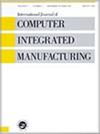A digital twin reference architecture for pharmaceutical cannabis production
IF 4
3区 工程技术
Q2 COMPUTER SCIENCE, INTERDISCIPLINARY APPLICATIONS
International Journal of Computer Integrated Manufacturing
Pub Date : 2023-09-12
DOI:10.1080/0951192x.2023.2257635
引用次数: 0
Abstract
The production of pharmaceutical cannabis is a complex and dynamic industry that has to meet critical challenges concerning product quality, compliance, traceability, food safety, sustainability and health. Digital twins have the potential to be powerful enablers for producers to meet these challenges. However, digital twins for the pharmaceutical production of cannabis are still under exploration and not yet researched. This paper contributes to overcoming this situation by proposing a reference architecture for the development and implementation of digital twins in this domain. Based on a design-oriented methodology, it defines and applies a coherent set of architecture views for modelling digital twin-based systems. Furthermore, a proof of concept of an immersive digital twin has been developed in order to test the applicability of reference architecture. This digital twin is developed in the open, cross-industry platform Unity and includes an extensive 3D model of a cannabis production facility. It is connected with real-world data through an application programming interface integration displaying real-time sensor data from a live greenhouse. The 3D environment is fully explorable, where the user takes control of an avatar character to walk around the facility and view real-time sensor readings. The expert validation shows that the developed digital twin is a valuable and innovative first step for remote management of pharmaceutical cannabis production. Further developments are needed to leverage its full potential, especially adding more types of sensor data, developing implementation-specific 3D models, extending the digital twin with predictive and prescriptive capabilities and connecting it to actuators.用于药用大麻生产的数字孪生参考架构
药用大麻的生产是一个复杂而充满活力的行业,必须应对产品质量、合规性、可追溯性、食品安全、可持续性和健康方面的重大挑战。数字孪生体有潜力成为生产商应对这些挑战的强大推动力。然而,用于大麻制药生产的数字双胞胎仍在探索中,尚未进行研究。本文通过为该领域的数字孪生的开发和实现提出一个参考体系结构,有助于克服这种情况。基于面向设计的方法,它定义并应用了一组连贯的体系结构视图,用于对基于数字孪生的系统进行建模。此外,为了测试参考架构的适用性,还开发了沉浸式数字孪生的概念验证。这个数字双胞胎是在开放的跨行业平台Unity中开发的,包括大麻生产设施的广泛3D模型。它通过应用程序编程接口集成显示来自现场温室的实时传感器数据,与现实世界的数据相连接。3D环境是完全可探索的,用户控制一个虚拟角色在设施周围走动,并查看实时传感器读数。专家验证表明,开发的数字双胞胎是远程管理药用大麻生产的有价值和创新的第一步。为了充分发挥其潜力,需要进一步开发,特别是增加更多类型的传感器数据,开发特定于实施的3D模型,扩展具有预测和规范功能的数字孪生体,并将其连接到执行器。
本文章由计算机程序翻译,如有差异,请以英文原文为准。
求助全文
约1分钟内获得全文
求助全文
来源期刊
CiteScore
9.00
自引率
9.80%
发文量
73
审稿时长
10 months
期刊介绍:
International Journal of Computer Integrated Manufacturing (IJCIM) reports new research in theory and applications of computer integrated manufacturing. The scope spans mechanical and manufacturing engineering, software and computer engineering as well as automation and control engineering with a particular focus on today’s data driven manufacturing. Terms such as industry 4.0, intelligent manufacturing, digital manufacturing and cyber-physical manufacturing systems are now used to identify the area of knowledge that IJCIM has supported and shaped in its history of more than 30 years.
IJCIM continues to grow and has become a key forum for academics and industrial researchers to exchange information and ideas. In response to this interest, IJCIM is now published monthly, enabling the editors to target topical special issues; topics as diverse as digital twins, transdisciplinary engineering, cloud manufacturing, deep learning for manufacturing, service-oriented architectures, dematerialized manufacturing systems, wireless manufacturing and digital enterprise technologies to name a few.

 求助内容:
求助内容: 应助结果提醒方式:
应助结果提醒方式:


